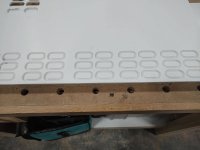4nthony
Member
When using my Origin, I've been struggling to get the right about amount of glide, if that's the right word. I find myself having to slightly unweight (lift) the leading edge in order to follow the path clean and not be too jerky.
I read that the base was engineered for a specific amount of friction and that it shouldn't be waxed but mine feels like there's too much friction. It's the same on both Plate and Workstation, as well as on plywood and hardwood.
I have some scratches on the base but it doesn't really look any different from the baseplates on my other routers.
With a 1/4" bit, I typically make passes around 3mm deep. I'm still using the original bit so there's a chance it could be getting dull, but I remember the friction from day one.
Does anyone else feel like their Origin is a bit too grippy?
I read that the base was engineered for a specific amount of friction and that it shouldn't be waxed but mine feels like there's too much friction. It's the same on both Plate and Workstation, as well as on plywood and hardwood.
I have some scratches on the base but it doesn't really look any different from the baseplates on my other routers.
With a 1/4" bit, I typically make passes around 3mm deep. I'm still using the original bit so there's a chance it could be getting dull, but I remember the friction from day one.
Does anyone else feel like their Origin is a bit too grippy?

